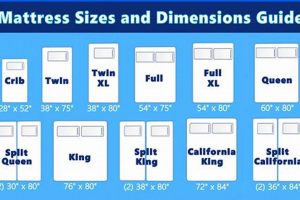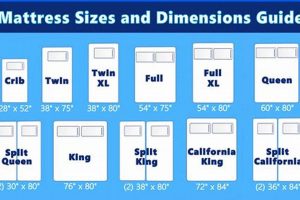The dimensions of a sleeping surface designed for infants and toddlers are a critical consideration when selecting bedding. These measurements directly impact the safety and comfort of the child using the cot. For example, a standard interior for North American cots requires a mattress that is approximately 28 inches wide and 52 inches long. Variations may exist depending on the cot’s origin and manufacturer.
Properly fitted bedding ensures a secure environment, minimizing the risk of entrapment or suffocation. Historically, variations in sleeping surface dimensions led to inconsistent safety standards. Today, standardized sizing aims to address these concerns, offering parents and caregivers greater confidence in the products they select. A correctly sized sleeping surface supports healthy sleep patterns, which are essential for the child’s development and well-being.
Understanding the nuances of these dimensions is therefore essential. The following article will delve deeper into the standards and variations encountered when choosing appropriate bedding, materials, and safety features for cots.
Selecting appropriate bedding involves careful attention to critical dimensions. Prioritizing accuracy is paramount to ensure a secure and comfortable sleep environment for the child.
Tip 1: Adhere to Manufacturer Specifications. Always consult the cot manufacturers guidelines for recommended bedding dimensions. Deviations can compromise safety.
Tip 2: Precise Measurements are Crucial. Accurately measure the interior dimensions of the cot to determine the precise bedding dimensions required. Use a reliable measuring tool.
Tip 3: Prioritize a Snug Fit. The bedding should fit snugly within the cot frame, leaving no gaps that could pose a safety hazard.
Tip 4: Consider Mattress Thickness. Evaluate the mattress thickness in relation to the cot’s side height to prevent a child from climbing out. Guidelines often specify a maximum mattress height.
Tip 5: Verify Compliance with Safety Standards. Ensure the bedding meets relevant safety standards established by regulatory bodies. Check for certifications from recognized organizations.
Tip 6: Check Firmness Rating. Ensure the mattress has the proper firmness, as soft mattresses can create a suffocation hazard for infants.
Tip 7: Regular Inspection for Wear. Routinely inspect the bedding for signs of wear and tear, such as rips, tears, or sagging, which may necessitate replacement.
Attention to these considerations promotes a safe and secure environment for infant rest, promoting both physical well-being and parental peace of mind.
The following sections will provide information on selecting suitable materials and hygiene practices.
1. Length
Length, in the context of bedding designed for infant cots, is a critical dimension that directly impacts safety and functionality. Its proper measurement ensures a secure fit within the cot frame, minimizing potential hazards.
- Standardized Measurements
Standardized dimensions, commonly around 52 inches, are prevalent in North American cots. Adhering to these standards ensures interchangeability and reduces the risk of purchasing an incompatible mattress. Deviation from these standardized lengths may lead to an ill-fitting mattress, compromising safety.
- Gap Prevention
The primary function of appropriate bedding length is to prevent the creation of gaps between the mattress and the cot frame. Such gaps can pose a significant risk of entrapment, where an infant may become lodged, leading to potential injury or suffocation. A snug fit is paramount to mitigate this risk.
- Impact on Comfort
While safety is paramount, length also influences the comfort of the sleeping surface. A mattress of inadequate length may not provide adequate support for the infant’s body, potentially leading to discomfort and disrupted sleep. A mattress that is excessively long may buckle or bunch, creating uneven surfaces.
- Variations and Considerations
While standards exist, variations in cot dimensions are possible, particularly with European or custom-designed cots. In these cases, precise measurement of the cot’s interior length is crucial to ensure a properly fitted mattress. Consideration should be given to the impact of blankets and bedding on the available space.
The length of the mattress, therefore, is not merely a measurement but a critical safety parameter. Proper selection and verification of this dimension are essential to providing a secure and comfortable sleeping environment for infants. Ensuring a correct fit prevents potential hazards and supports healthy sleep patterns.
2. Width
Width, in conjunction with length, is a fundamental dimension defining the sleeping surface. The width directly affects the available space for the infant and the overall safety of the cot environment. Standard bedding products typically adhere to a width of approximately 28 inches for North American cots. This dimension is engineered to provide sufficient room for movement while minimizing the risk of entrapment between the mattress and cot sides. Deviations from this specified width, whether too narrow or too wide, can compromise the designed safety features of the cot. For instance, a mattress with inadequate width may allow a gap to form, increasing the potential for an infant’s limb to become trapped. Conversely, excessive width can cause the mattress to compress against the cot sides, potentially hindering proper ventilation and possibly causing a less firm and unsafe sleeping surface.
Understanding the critical role of width is particularly pertinent when using older or non-standard cots. These cots may not conform to contemporary size specifications, necessitating precise measurements to ensure proper bedding fit. For example, antique cots, often smaller than modern counterparts, require custom-made mattresses to guarantee safe dimensions. A case study of emergency room admissions for infant injuries revealed that a significant percentage of incidents were attributed to ill-fitting mattresses in older cots, highlighting the real-world consequences of neglecting width considerations. The practical implication of understanding mattress width extends to situations involving travel cots or portable cribs, which may also have unique size requirements. Therefore, care givers should not assume a ‘one size fits all’ when choosing a mattress.
The appropriate width, therefore, represents a crucial safety parameter when selecting infant bedding. Prioritizing accuracy and adherence to manufacturer guidelines is essential for preventing potential hazards. Selecting bedding with correct width not only contributes to a safer sleeping environment, but also promotes more restful sleep for the child. By ensuring an accurate and compliant fit, caregivers can mitigate risks and support healthy infant development. Neglecting mattress width, or any other dimension is not an option.
3. Thickness
Thickness, as it relates to bedding designed for infant cots, is a dimension that significantly influences safety and comfort. Its proper selection is critical to prevent potential hazards associated with the cot’s design.
- Relationship with Cot Side Height
Thickness is inextricably linked to the height of the cot’s sides. Regulatory standards mandate minimum side heights to prevent infants from climbing out. A mattress that is too thick reduces this effective side height, increasing the risk of falls. Conversely, an excessively thin mattress may not provide adequate cushioning and support. Manufacturers specify maximum allowable mattress thickness to maintain compliance with safety regulations.
- Impact on Entrapment Risks
While primarily associated with length and width, thickness also indirectly affects entrapment risks. An improperly sized mattress, particularly one that is too thin, can create or exacerbate gaps between the mattress and the cot frame. These gaps can pose a danger to infants, potentially leading to limb entrapment or suffocation. Thus, appropriate thickness is a factor in ensuring a snug and secure fit.
- Material Composition and Support
Thickness often correlates with the internal material composition of the mattress. Thicker mattresses may contain additional layers of padding or support materials, potentially influencing the level of firmness and comfort. However, increased thickness does not automatically equate to superior support or safety. Material density and construction quality are equally important factors. A thicker mattress that is excessively soft poses the same risks as a thin, inadequate one.
- Ventilation Considerations
The thickness of a cot mattress can impact air circulation within the cot. A very thick mattress may restrict airflow, potentially leading to increased humidity and temperature build-up within the sleeping environment. Proper ventilation is essential to reduce the risk of overheating and create a comfortable sleep environment. Manufacturers may incorporate ventilation features into mattress design to address this issue.
Therefore, the selection of appropriate mattress thickness demands careful consideration of its interplay with cot side height, entrapment risks, material composition, and ventilation. Adherence to manufacturer guidelines and regulatory standards is essential to ensure a safe and comfortable sleeping environment for infants. Neglecting the thickness dimension may compromise safety and well-being.
4. Firmness
The firmness of bedding designed for cots is a critical safety parameter intrinsically linked to size considerations. It impacts infant safety by influencing the risk of suffocation and Sudden Infant Death Syndrome (SIDS).
- Prevention of Suffocation Risk
Excessively soft sleeping surfaces elevate the risk of suffocation due to an infant’s inability to reposition if their face becomes pressed against the material. A properly firm surface minimizes this risk. The appropriate surface density ensures the infant can maintain an open airway. Examples from product testing consistently demonstrate that firmer surfaces reduce simulated suffocation events.
- SIDS Mitigation
Research suggests a correlation between overly soft surfaces and an increased risk of SIDS. A firm mattress provides a more stable and consistent sleeping environment. While the exact mechanisms linking firmness to SIDS are still under investigation, public health recommendations consistently emphasize the importance of using a firm sleeping surface for infants.
- Developmental Support
A properly firm surface supports healthy spinal development and posture. Excessive softness can lead to unnatural spinal alignment. The structural integrity of the sleeping surface contributes to the infant’s overall physical development. Infant care specialists recommend firm surfaces as a preventative measure against postural issues.
- Compliance Standards
Regulatory bodies, such as the Consumer Product Safety Commission (CPSC), set specific standards for mattress firmness. These standards aim to ensure manufacturers produce bedding that meets minimum safety requirements. Compliance with these standards is essential for minimizing the risk of infant injuries and fatalities. Retailers and consumers should verify that bedding products meet these requirements.
These facets highlight the critical role of firmness in ensuring infant safety within the context of bedding product dimensions. Adherence to firmness standards, along with correct length, width and thickness, represents a multi-faceted approach to mitigating risks and supporting healthy development.
5. Fit
The “fit” of bedding within a cot is a direct consequence of selecting appropriate dimensions. The length, width, and thickness contribute to a seamless integration with the cot’s frame. A poor match increases the risk of entrapment and suffocation. The correct fit, conversely, provides a safe sleeping environment. For instance, a mattress that is too small creates gaps along the cot sides, while one that is too large can buckle, creating an uneven surface and potential climbing hazard. A proper fit ensures consistent support, contributing to the overall safety and comfort of the infant.
Practical application of the “fit” concept requires accurate measurement of the cot’s interior dimensions prior to purchasing any bedding. Manufacturers typically provide size specifications for their cots, and it is essential to verify that the bedding dimensions align with these recommendations. This includes confirming the correct thickness to maintain sufficient side rail height. A real-world example involves a recall of cots due to design flaws that, when coupled with standard bedding, resulted in inadequate side rail height, leading to an increased risk of falls. Regular inspection is necessary to ensure that the bedding maintains its fit over time, particularly after washing, which can sometimes cause shrinkage or distortion.
In summary, the “fit” of bedding serves as a final verification of dimension accuracy. Accurate bedding size promotes safety by preventing gaps, maintaining side rail height, and ensuring even support. Parents must understand the practical significance of a correct fit by taking measurements and regularly verifying bedding condition. Achieving a proper fit is a critical element in promoting a secure and comfortable sleeping environment.
6. Compliance
Regulatory compliance, as it pertains to bedding intended for infant cots, is directly linked to established size standards. These standards, often mandated by governmental bodies or industry organizations, define acceptable length, width, and thickness ranges. Bedding that does not adhere to these dimensions is considered non-compliant and may pose a safety risk. The rationale behind this direct connection lies in the critical role of accurate dimensions in preventing hazards such as entrapment or suffocation. For example, if a mattress is manufactured with a width exceeding the specified maximum, it may compress against the cot sides, potentially restricting airflow. Similarly, a mattress shorter than the mandated minimum can create dangerous gaps.
Verification of compliance typically involves rigorous testing procedures conducted by accredited laboratories. These tests assess dimensional accuracy, material safety, and construction integrity. Bedding products that pass these tests are often labeled with certifications, indicating adherence to recognized standards. However, instances of non-compliant bedding persist. For example, reports of imported cots with undersized mattresses highlight the challenge of enforcing dimensional standards across international markets. These situations emphasize the responsibility of retailers and consumers to verify compliance claims and choose products from reputable manufacturers.
In conclusion, compliance with dimensional standards is not merely a formality but a fundamental aspect of bedding safety. Failure to meet these standards can lead to preventable injuries or fatalities. Understanding the significance of dimensional compliance empowers consumers to make informed purchasing decisions, ensuring that the bedding they select provides a secure and healthy environment for infants.
Frequently Asked Questions Regarding Cot Mattress Size
The following addresses common inquiries concerning the proper dimensions of infant cot mattresses, emphasizing safety and compliance with established standards.
Question 1: What are the standard dimensions for a cot mattress?
The standard dimensions vary depending on region, but in North America, a typical cot mattress measures approximately 28 inches in width and 52 inches in length. Thickness varies but must allow a safe distance from the top of the mattress to the top of the cot rail.
Question 2: Why is correct cot mattress size important?
A correctly sized mattress prevents gaps between the mattress and the cot frame, reducing the risk of infant entrapment, suffocation, and falls.
Question 3: How do I measure my cot to determine the appropriate mattress size?
Measure the interior length and width of the cot frame, from edge to edge. Consult the manufacturer’s specifications for the recommended mattress dimensions.
Question 4: What happens if the cot mattress is too small?
A mattress that is too small creates gaps, posing a significant entrapment hazard. The infant may become lodged in these gaps, leading to injury or suffocation.
Question 5: What happens if the cot mattress is too large?
A mattress that is too large may compress against the cot sides, potentially reducing airflow and creating an uneven sleeping surface. It may also reduce the height of the cot rail to an unsafe level.
Question 6: Where can I find information on cot mattress size safety standards?
Information on safety standards can be obtained from regulatory bodies, such as the Consumer Product Safety Commission (CPSC) in the United States, or by consulting the cot manufacturer’s documentation.
Prioritizing correct mattress dimensions for infant cots is paramount to minimizing safety risks and fostering a secure sleeping environment.
The subsequent section will focus on selecting appropriate mattress materials and construction techniques.
Conclusion
The preceding discussion has explored the critical importance of bedding designed for infant cots. Dimensions, including length, width, thickness, and firmness, directly impact the safety and well-being of the child. Adherence to established standards and guidelines is paramount. Failure to select appropriate bedding can lead to preventable injuries or fatalities.
Therefore, vigilance is essential. Parents and caregivers must prioritize understanding the specific requirements and exercising due diligence in product selection. The information presented serves as a reminder of the ongoing need for responsible and informed decision-making in providing a safe sleep environment for infants.


![Best Intex Queen Size Inflatable Mattress [Guide 2024] Organic & Natural Mattress Buyer’s Guide: Non-Toxic Sleep Solutions Best Intex Queen Size Inflatable Mattress [Guide 2024] | Organic & Natural Mattress Buyer’s Guide: Non-Toxic Sleep Solutions](https://mattressworldpa.com/wp-content/uploads/2025/07/th-2231-300x200.jpg)




